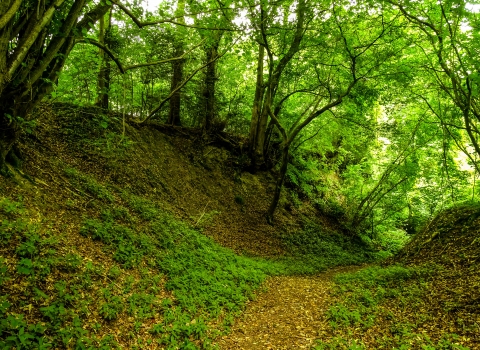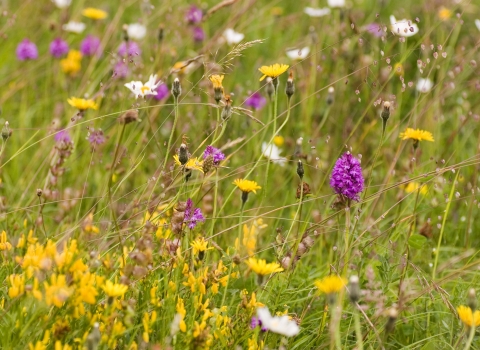There is very limited parking - please do not block the road.
Please keep dogs on leads at all times. Please take dog mess and litter home with you. Thank you.

The Knapp and Papermill by Paul Lane
The Knapp and Papermill Nature Reserve
Location
Know before you go
Dogs
Please keep dogs (& yourselves) out of the Leigh Brook and take dog mess away with you
When to visit
Opening times
The reserve is open 9am-6pm, the gate will be locked outside of these times. Security patrols will be taking place.Best time to visit
All year roundAbout the reserve
The trail around The Knapp and Papermill starts in an apple orchard with old lichen-encrusted trees that attract nuthatches and green woodpeckers. In autumn and early winter visitors should keep an eye out for butterflies such as red admiral and peacock or birds like fieldfare and redwing feasting on the fallen fruit.
The Leigh Brook has cut a winding valley with steep woodlands and rich meadows. Look for grey wagtails and dippers on the brook and, during the winter months, listen for flocks of long-tailed tits and siskins in the brook-side alders. Dragonflies and damselflies thrive on the brook during spring and summer but only the luckiest of visitors may catch sight of an otter. The trail takes visitors along the brook, around meadows and through woodland.
Big Meadow is a hay meadow with flowers such as knapweed, ox-eye daisy and yellow rattle together with a scattering of green-winged and common spotted orchids. Papermill Meadow is an old pasture on slightly more acid soil. This meadow is a favourite hunting ground for buzzards that breed in the valley. The much smaller Tor Meadow has orchids and cowslips. Butterflies frequent all three meadows and more than 30 species have been recorded here including common and holly blue, brimstone, purple hairstreak and white admiral. Each meadow is maintained by hay cutting and/or grazing.
Woodland occupies about half the reserve and some areas are managed by coppicing. This traditional method of cutting down young stems to near ground level on a rotation ensures that trees never die and there is always a range of habitats for wildlife at different stages of re-growth. Coppicing helps to encourage the marvellous carpet of bluebells and other wildflowers (yellow archangel, stitchwort and wild garlic) that can be seen each spring. Wild service trees grow in profusion here along with both small and large-leaved lime as well as oaks and hazels. Dormice are encouraged through the provision of nest boxes, as are many species of birds and bats. The reserve is important for bats and 11 of the UK’s 17 regular breeding species are found here.
A trail leaflet and family guide are available from the small information centre near the entrance or to download below. You're more than welcome to bring a picnic but please eat it in our designated picnic area between the entrance and information centre; you won't need to carry your food so far and will help protect delicate flowers and wildlife from being trampled and sat on. Thank you.
Bigger, better and more joined up
We believe that a landscape-scale approach to wildlife conservation is essential. Wildlife needs space to adapt and move to cope with the consequences of climate change. Practically, this means that we need our countryside to be bigger, better and more joined up to provide a coherent network of large areas linked by corridors that can provide benefits for people as well as for biodiversity.
A visitor and volunteers building has been built using sustainable principles and including excellent provision for bats. The nature reserve lies within the Teme Valley priority Living Landscapes area and the Malvern Hills Area of Outstanding Natural Beauty.
Species
Contact us
Environmental designation
Location map
Signage at The Knapp and Papermill
Leaflets at The Knapp and Papermill
Become a member
If you enjoy visiting our nature reserves, join us today to help us manage and protect them.



